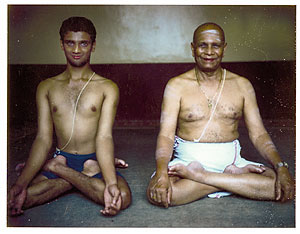
Joy: Do we list this under the category of advanced practices?
David: No this is actually very basic classical yoga 101 stuff. Sharath presented this on purpose to the whole group who range from raw beginners to serious veterans. These concepts are fundamental and point to how to purify your body and better inwardly view the practice. I guarantee that most veteran Ashtanga heads have practiced at least some of these kriyas (Neti, Nauli, Trataka, Kapalabhati) as a way of furthering internal cleansing and better understanding their ashtanga practice.
Sharath spoke about each of the **6 classic yogic cleansing practices (Kriya's-Neti, Nauli, Dhauti, Vasti, Trataka, Kapalabhati see below) and concluded that Ashtanga practice achieves the same benefits and thus largely replaces these practices. However because Sharath took the time to discuss these practices, I conclude that knowledge of these can give you new and valuable ideas for how to think and approach your ashtanga practice.
For example take Neti, Nauli, Dhauti, and Vasti; all of these relate to cleansing the entire digestive tract from mouth to anus. The quality, quantity, breadth, depth and intensity of the asana work we do in ashtanga is equally potent for thorough internal cleansing that includes purifying the digestive tract. This simple fact alone can inspire you to practice and help carry you across challenging times such as when you pass through a phase where you lack motivation to get up and get on the mat. Sharath spoke about how continuing to do this practice can help you look 10 to 15 years younger than your age—largely due to the digestive fire that results from practice. He even quipped that the answer to the perennial question 'Why do you do Yoga?' is 'to look younger'—what more reason do you need?—ha!
Also, the proper use of Jalandhara, Uddhyana, and Mula bandha's helps your body emulate and thus receive the same benefits as the 4 above mentioned cleansing practices. When you use ujjayi breathing to draw the breath in from the root of the palate, the flow of prana through the nasal passages and sinuses clears these passages, similar to the use of a neti pot. And frequently working with the 'take it up' action of mula bandha during vinyasa transitions can simulate the same sort of drawing up action from your base that vasti asks for. Also as you practice, the continual moderate lift of Uddhyana Bandha coupled with awareness of redirecting apana vayu upwards when inhaling and exhaling can create an equally effective nauli like 'churning' of the abdominal region.
The similiarities between dristi and trataka are obvious; essentially dristi is a form of trataka and the fact that both systems emphasize the value of gazing in practice serves as a reminder that meditation and all inner work are greatly enhanced by cultivating awareness of where and how you orient your self visually. The movements of the spine are intimately connected with how you orient your posture through your eyes and what you see moment to moment. Both meditation and graceful movement have origins in awareness of the integrity of the body's central axis from the base, seat of Mula Bandha, along the length of the spine to the neck and head and finally through eyes in the form of the gaze, the Dristi.
Sharath briefly demonstrated the technique of kalapabhati, suggesting that people try it, and thus somewhat singled it out as a practice that could perhaps add dimension to your breath work and provide something energetically new that straightforward ujjayi might not provide.
Lastly Sharath spoke about what Yoga ultimately is about: 'uncovering the God within'. Each person is Brahman (the 'real, conscious, blissful' Self) but there are enemies within, anger, greed, jealousy, delusion, etc that cover this truth. I find it helpful to sit with the image of covering versus uncovering–yoga practice dissolves the coverings that obscure us and thus helps us uncover our Spirit. We can too easily make the mistake of thinking that the 'positive' coverings, the more superficial, outer pursuits are all there is and not even bother to dig down, go inwards, cross our joyous and challenging waters and sort through our inner enemies, our blindness to our strengths as well to our greed and our anger. And also we can feel like there is something wrong with us for our hunger, our need to search for depth and meaning, something wrong for being 'unhappy' or dissatisfied or having to struggle so much to make progress on our paths. To me Ashtanga or any serious spiritual practice is not necessarily for the 'happy', the well adapted, the contented, the ones who find what they are looking for in getting, spending, or who continue to place more value in pursuits outside of themselves. Ashtanga is for the hungry, the ones who have something gnawing inside, the ones who honestly aren't happy accepting complacent norms. Ashtanga is for those who are alive with intense feelings that there are worlds to discover, worlds that are found by reaching passionately inwards for expression that will contribute to personal and collective healing.
Comments
No comments.